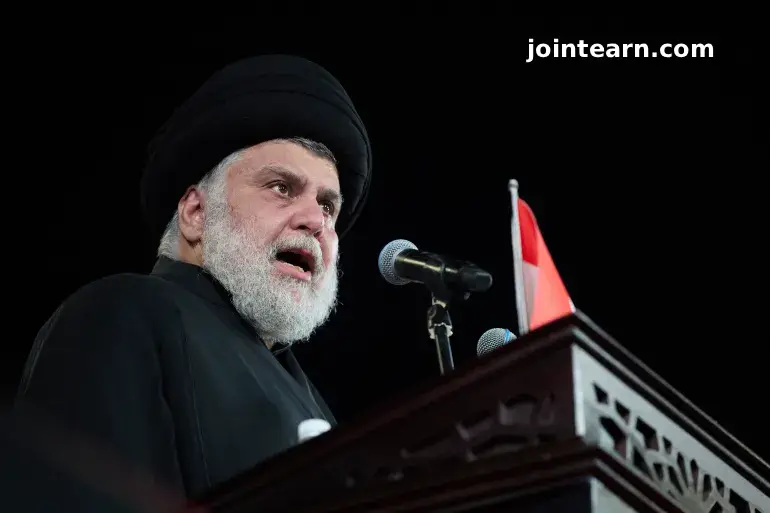
Baghdad, October 19, 2025 – As Iraq approaches its November elections, the country’s most influential Shia cleric, Muqtada al-Sadr, has again shaken up the political landscape. Despite announcing a boycott, analysts believe al-Sadr’s move is part of a carefully calculated power strategy—one that positions his bloc for a commanding return when Iraq’s current political order falters.
Al-Sadr, who withdrew his bloc from parliament in June 2022, has framed his absence as a moral stand against corruption and sectarianism. Yet, behind the scenes, his movement remains deeply involved in shaping Iraq’s political future, aiming for a government that operates on “national majority” principles rather than entrenched power-sharing.
Al-Sadr’s Tactical Withdrawal: Boycott or Long Game?
In a statement last month, al-Sadr said his movement would sit out the 2025 elections, pledging to “change the faces and save Iraq.” This statement echoes his earlier calls for complete system reform, while quietly preserving the Sadrist Movement’s influence through social networks, loyal clerics, and street mobilization.
Sources close to al-Sadr reveal that his withdrawal is less a boycott than a tactical pause. His strategy hinges on allowing Iraq’s current government—led by Prime Minister Mohammed Shia al-Sudani and dominated by the Shia Coordination Framework (SCF)—to crumble under public frustration, paving the way for the Sadrists’ triumphant return.
“He’s waiting for the system to collapse from within,” said a political insider. “When that happens, he’ll be the only organized force capable of restoring order.”
Behind the scenes, Sadrists had reportedly attempted to negotiate an extension to the election registration period with al-Sudani, seeking a conditional re-entry into the race. However, when those talks failed, al-Sadr abruptly ended them with a handwritten note tagged #Boycotters, reasserting his political distance.
The 2022 Fallout: A “National Majority” Thwarted
Al-Sadr’s 2022 withdrawal followed the collapse of his plan to form Iraq’s first “national majority government.” His coalition, Inqath Watan (Saving a Homeland)—comprising the Sadrists, Kurdish Democratic Party (KDP), and Sunni bloc Taqadum—secured 175 of 329 parliamentary seats, enough for a majority.
However, Iraq’s Federal Supreme Court ruled that electing a president required a two-thirds quorum, effectively blocking the Sadrists’ majority and empowering the SCF to form what became known as the “obstructing third.”
Unable to form his desired government, al-Sadr ordered his bloc to resign from parliament, transferring their 73 seats to SCF-affiliated candidates. He then leveraged his mass street power, mobilizing supporters in Baghdad’s Green Zone and across southern Iraq to protest what he called a “stolen democracy.”
The ensuing clashes ended only when al-Sadr personally ordered his followers to withdraw, demonstrating both his control over his base and his ability to halt violence when it served his political interests.
SCF’s Grip and Governance Troubles
Since al-Sadr’s exit, the Shia Coordination Framework has tightened its control over key state institutions—removing Sadrist officials from government posts, pursuing legal cases against opponents, and centralizing power under Prime Minister al-Sudani.
Yet, this consolidation has come at a cost. Iraq faces an unprecedented economic strain, with public sector wages and welfare consuming over 99 percent of oil revenues in the first half of 2025. U.S. sanctions, allegations of Iranian influence, and fears of regional conflict have further weakened the government’s standing.
“The SCF has overextended itself,” said Dr. Ahmed al-Mashhadani, a Baghdad-based analyst. “If the economy collapses or U.S. sanctions deepen, al-Sadr’s narrative of reform and independence will gain unstoppable traction.”
Rebranding and Religious Strategy
Since his 2022 exit, al-Sadr has rebranded his movement as the Patriotic Shia Current, emphasizing religious authenticity and national independence. He continues to mobilize Iraq’s Shia majority around moral and nationalist themes—challenging the SCF’s claim to religious legitimacy.
Al-Sadr has also reclaimed symbolic spaces like Baghdad’s Tahrir Square and Nasiriyah’s Haboubi Square, historically associated with anti-government protests. His participation in Ashura 2025, where his movement organized public services for pilgrims, showcased his renewed engagement with Iraq’s grassroots Shia base.
Regionally, al-Sadr has distanced himself from Iran’s hardline allies while maintaining ties with Arab states and Western diplomats. He condemned the war in Gaza and voiced support for Syrian regime change, cultivating an image of moderation that appeals to both domestic and international audiences.
The Endgame: Waiting for the Collapse
For now, al-Sadr’s strategy appears to be strategic patience. By staying out of government, he avoids accountability for Iraq’s crises while maintaining his image as a reformer and protector of the people.
If the SCF’s administration collapses under internal pressure or external sanctions, al-Sadr and his Patriotic Shia Current are poised to fill the vacuum, reshaping Iraq’s political order on their own terms.
“Al-Sadr doesn’t need to win elections today,” said political scientist Rana al-Tamimi. “He just needs Iraq’s system to fail tomorrow.”
Leave a Reply